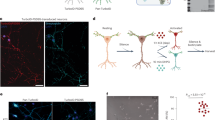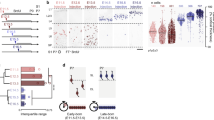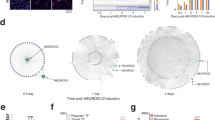Abstract
Serum inducible kinase (SNK), also known as polo-like kinase 2 (PLK2), is a known regulator of mitosis, synaptogenesis and synaptic homeostasis. However, its role in early cortical development is unknown. Herein, we show that snk is expressed in the cortical plate from embryonic day 14, but not in the ventricular/subventricular zones (VZ/SVZ), and SNK protein localizes to the soma and dendrites of cultured immature cortical neurons. Loss of SNK impaired dendritic but not axonal arborization in a dose-dependent manner and overexpression had opposite effects, both in vitro and in vivo. Overexpression of SNK also caused abnormal branching of the leading process of migrating cortical neurons in electroporated cortices. The kinase activity was necessary for these effects. Extracellular signal-regulated kinase (ERK) pathway activity downstream of brain-derived neurotrophic factor (BDNF) stimulation led to increases in SNK protein expression via transcriptional regulation, and this upregulation was necessary for the growth-promoting effect of BDNF on dendritic arborization. Taken together, our results indicate that SNK is essential for dendrite morphogenesis in cortical neurons.
Similar content being viewed by others
Log in or create a free account to read this content
Gain free access to this article, as well as selected content from this journal and more on nature.com
or
References
Kaufmann WE, Moser HW . Dendritic anomalies in disorders associated with mental retardation. Cereb Cortex 2000; 10:981–991.
Whitford KL, Dijkhuizen P, Polleux F, Ghosh A . Molecular control of cortical dendrite development. Annu Rev Neurosci 2002; 25:127–149.
Miller FD, Kaplan DR . Signaling mechanisms underlying dendrite formation. Curr Opin Neurobiol 2003; 13:391–398.
Glover DM, Hagan IM, Tavares AA . Polo-like kinases: a team that plays throughout mitosis. Genes Dev 1998; 12:3777–3787.
Nigg EA . Polo-like kinases: positive regulators of cell division from start to finish. Curr Opin Cell Biol 1998; 10:776–783.
Sunkel CE, Glover DM . polo, a mitotic mutant of Drosophila displaying abnormal spindle poles. J Cell Sci 1988; 89:25–38.
Simmons DL, Neel BG, Stevens R, Evett G, Erikson RL . Identification of an early-growth-response gene encoding a novel putative protein kinase. Mol Cel Biol 1992; 12:4164–4169.
Cizmecioglu O, Warnke S, Arnold M, Duensing S, Hoffmann I . Plk2 regulated centriole duplication is dependent on its localization to the centrioles and a functional polo-box domain. Cell Cycle 2008; 7:3548–3555.
Eckerdt F, Yuan J, Strebhardt K . Polo-like kinases and oncogenesis. Oncogene 2005; 24:267–276.
Matsumoto T, Wang PY, Ma W, et al. Polo-like kinases mediate cell survival in mitochondrial dysfunction. Proc Natl Acad Sci USA 2009; 106:14542–14546.
Seeburg DP, Pak D, Sheng M . Polo-like kinases in the nervous system. Oncogene 2005; 24:292–298.
Pak DT, Sheng M . Targeted protein degradation and synapse remodeling by an inducible protein kinase. Science 2003; 302:1368–1373.
Seeburg DP, Feliu-Mojer M, Gaiottino J, Pak DT, Sheng M . Critical role of CDK5 and Polo-like kinase 2 in homeostatic synaptic plasticity during elevated activity. Neuron 2008; 58:571–583.
Kauselmann G, Weiler M, Wulff P, et al. The polo-like protein kinases Fnk and Snk associate with a Ca(2+)- and integrin-binding protein and are regulated dynamically with synaptic plasticity. EMBO J 1999; 18:5528–5539.
Anderson SA, Marin O, Horn C, Jennings K, Rubenstein JL . Distinct cortical migrations from the medial and lateral ganglionic eminences. Development 2001; 128:353–363.
Ma S, Liu MA, Yuan YL, Erikson RL . The serum-inducible protein kinase Snk is a G1 phase polo-like kinase that is inhibited by the calcium- and integrin-binding protein CIB. Mol Cancer Res 2003; 1:376–384.
Bradke F, Dotti CG . Establishment of neuronal polarity: lessons from cultured hippocampal neurons. Curr Opin Neurobiol 2000; 10:574–581.
Draghetti C, Salvat C, Zanoguera F, et al. Functional whole-genome analysis identifies Polo-like kinase 2 and poliovirus receptor as essential for neuronal differentiation upstream of the negative regulator alphaB-crystallin. J Biol Chem 2009; 284:32053–32065.
Seeburg DP, Sheng M . Activity-induced Polo-like kinase 2 is required for homeostatic plasticity of hippocampal neurons during epileptiform activity. J Neurosci 2008; 28:6583–6591.
Davies AM . Neurotrophins: neurotrophic modulation of neurite growth. Curr Biol 2000; 10:R198–200.
Huang EJ, Reichardt LF . Trk receptors: roles in neuronal signal transduction. Annu Rev Biochem 2003; 72:609–642.
Huang Z, Zang K, Reichardt LF . The origin recognition core complex regulates dendrite and spine development in postmitotic neurons. J Cell Biol 2005; 170:527–535.
Nebreda AR . CDK activation by non-cyclin proteins. Curr Opin Cell Biol 2006; 18:192–198.
Tatsuno I, Hirai A, Saito Y . Cell-anchorage, cell cytoskeleton, and Rho-GTPase family in regulation of cell cycle progression. Prog Cell Cycle Res 2000; 4:19–25.
Van Aelst L, Cline HT . Rho GTPases and activity-dependent dendrite development. Curr Opin Neurobiol 2004; 14:297–304.
Zukerberg LR, Patrick GN, Nikolic M, et al. Cables links Cdk5 and c-Abl and facilitates Cdk5 tyrosine phosphorylation, kinase upregulation, and neurite outgrowth. Neuron 2000; 26:633–646.
Archambault V, D'Avino PP, Deery MJ, Lilley KS, Glover DM . Sequestration of Polo kinase to microtubules by phosphopriming-independent binding to Map205 is relieved by phosphorylation at a CDK site in mitosis. Genes Dev 2008; 22:2707–2720.
Feng Y, Hodge DR, Palmieri G, et al. Association of polo-like kinase with alpha-, beta- and gamma-tubulins in a stable complex. Biochem J 1999; 339:435–442.
Neef R, Preisinger C, Sutcliffe J, et al. Phosphorylation of mitotic kinesin-like protein 2 by polo-like kinase 1 is required for cytokinesis. J Cell Biol 2003; 162:863–875.
Lee J, Jeong Y, Jeong S, Rhee K . Centrobin/NIP2 is a microtubule stabilizer whose activity is enhanced by PLK1 phosphorylation during mitosis. J Biol Chem 2010; 285:25476–25484.
Wang Q, Xie S, Chen J, et al. Cell cycle arrest and apoptosis induced by human Polo-like kinase 3 is mediated through perturbation of microtubule integrity. Mol Cell Biol 2002; 22:3450–3459.
Arai T, Haze K, Iimura-Morita Y, et al. Identification of beta-catenin as a novel substrate of Polo-like kinase 1. Cell Cycle 2008; 7:3556–3563.
Kaplan DD, Meigs TE, Kelly P, Casey PJ . Identification of a role for beta-catenin in the establishment of a bipolar mitotic spindle. J Biol Chem 2004; 279:10829–10832.
Bahmanyar S, Guiney EL, Hatch EM, Nelson WJ, Barth AI . Formation of extra centrosomal structures is dependent on beta-catenin. J Cell Sci 2010; 123:3125–3135.
Yu X, Malenka RC . Beta-catenin is critical for dendritic morphogenesis. Nat Neurosci 2003; 6:1169–1177.
Dai BN, Yang Y, Chau Z, Jhanwar-Uniyal M . Polo-like kinase 1 regulates RhoA during cytokinesis exit in human cells. Cell Prolif 2007; 40:550–557.
Lowery DM, Clauser KR, Hjerrild M, et al. Proteomic screen defines the Polo-box domain interactome and identifies Rock2 as a Plk1 substrate. EMBO J 2007; 26:2262–2273.
Glotzer M . Cytokinesis: progress on all fronts. Curr Opin Cell Biol 2003; 15:684–690.
Koh CG . Rho GTPases and their regulators in neuronal functions and development. Neurosignals 2006; 15:228–237.
Pak DT, Yang S, Rudolph-Correia S, Kim E, Sheng M . Regulation of dendritic spine morphology by SPAR, a PSD-95-associated RapGAP. Neuron 2001; 31:289–303.
Kumar V, Zhang MX, Swank MW, Kunz J, Wu GY . Regulation of dendritic morphogenesis by Ras-PI3K-Akt-mTOR and Ras-MAPK signaling pathways. J Neurosci 2005; 25:11288–11299.
Messaoudi E, Ying SW, Kanhema T, Croll SD, Bramham CR . Brain-derived neurotrophic factor triggers transcription-dependent, late phase long-term potentiation in vivo. J Neurosci 2002; 22:7453–7461.
Schratt GM, Nigh EA, Chen WG, Hu L, Greenberg ME . BDNF regulates the translation of a select group of mRNAs by a mammalian target of rapamycin-phosphatidylinositol 3-kinase-dependent pathway during neuronal development. J Neurosci 2004; 24:7366–7377.
Dijkhuizen PA, Ghosh A . BDNF regulates primary dendrite formation in cortical neurons via the PI3-kinase and MAP kinase signaling pathways. J Neurobiol 2005; 62:278–288.
Brown EJ, Schreiber SL . A signaling pathway to translational control. Cell 1996; 86:517–520.
Cohen-Cory S, Kidane AH, Shirkey NJ, Marshak S . Brain-derived neurotrophic factor and the development of structural neuronal connectivity. Dev Neurobiol 2010; 70:271–288.
Yoshii A, Constantine-Paton M . Postsynaptic BDNF-TrkB signaling in synapse maturation, plasticity, and disease. Dev Neurobiol 2010; 70:304–322.
Turrigiano G . Homeostatic signaling: the positive side of negative feedback. Curr Opin Neurobiol 2007; 17:318–324.
Binder DK, Croll SD, Gall CM, Scharfman HE . BDNF and epilepsy: too much of a good thing? Trends Neurosci 2001; 24:47–53.
Inglis KJ, Chereau D, Brigham EF, et al. Polo-like kinase 2 (PLK2) phosphorylates alpha-synuclein at serine 129 in central nervous system. J Biol Chem 2009; 284:2598–2602.
Mbefo MK, Paleologou KE, Boucharaba A, et al. Phosphorylation of synucleins by members of the Polo-like kinase family. J Biol Chem 2010; 285:2807–2822.
McGeer PL, McGeer EG . The alpha-synuclein burden hypothesis of Parkinson disease and its relationship to Alzheimer disease. Exp Neurol 2008; 212:235–238.
Li S, Zhang C, Takemori H, Zhou Y, Xiong ZQ . TORC1 regulates activity-dependent CREB-target gene transcription and dendritic growth of developing cortical neurons. J Neurosci 2009; 29:2334–2343.
Zhou Y, Wu H, Li S, et al. Requirement of TORC1 for late-phase long-term potentiation in the hippocampus. PLoS One 2006; 1:e16.
Gartner A, Collin L, Lalli G . Nucleofection of primary neurons. Methods Enzymol 2006; 406:374–388.
Zheng J, Shen WH, Lu TJ, et al. Clathrin-dependent endocytosis is required for TrkB-dependent Akt-mediated neuronal protection and dendritic growth. J Biol Chem 2008; 283:13280–13288.
Acknowledgements
We thank Dr Xiao-Bing Yuan and members of his lab (Institute of Neuroscience, SIBS, CAS, China) for offering the use of their in vitro electroporation system. We also thank Chi Zhang (Institute of Neuroscience, SIBS, CAS, China) for her assistance with our cell culture procedures, as well as Bing-Fa Sun (Institute of Biochemistry and Cell Biology, SIBS, CAS, China) and Da-Feng Xu (East China University of Science and Technology, China) for assistance with our cloning procedures. This work was supported by grants from the 973 Program (2011CBA00407), NSFC (30925016; 31021063) and the Chinese Academy of Sciences (XDA01020305).
Author information
Authors and Affiliations
Corresponding author
Additional information
(Supplementary information is linked to the online version of the paper on the Cell Research website.)
Supplementary information
Supplementary information, Figure S1
SNK expression in the developing cortex and subcellular localization of SNKK108M in DIV3 cortical neurons. (PDF 105 kb)
Supplementary information, Figure S2
shRNA-scr has no effect on dendritic arborization. (PDF 42 kb)
Supplementary information, Figure S3
Knockdown efficiency of SNK shRNA constructs in DIV3 neurons. (PDF 116 kb)
Supplementary information, Figure S4
U73122 blocks PLCγ phosphorylation. (PDF 28 kb)
Rights and permissions
About this article
Cite this article
Guo, SL., Tan, GH., Li, S. et al. Serum inducible kinase is a positive regulator of cortical dendrite development and is required for BDNF-promoted dendritic arborization. Cell Res 22, 387–398 (2012). https://doi.org/10.1038/cr.2011.100
Received:
Revised:
Accepted:
Published:
Issue date:
DOI: https://doi.org/10.1038/cr.2011.100
Keywords
This article is cited by
-
Autism-associated CHD8 deficiency impairs axon development and migration of cortical neurons
Molecular Autism (2018)



